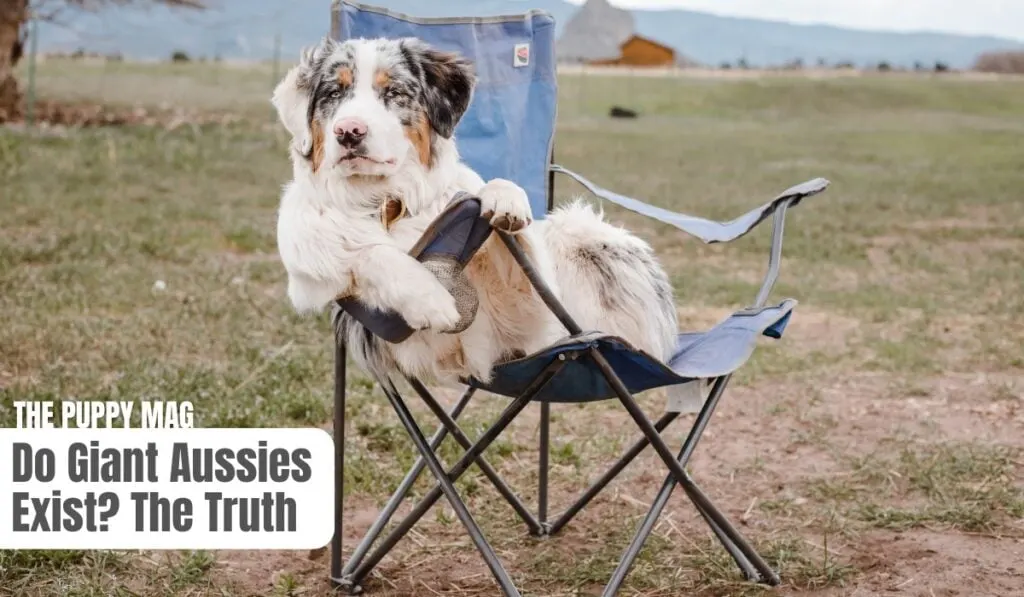If you love australian shepherds and are also a fan of big dogs, you’re probably wondering if “giant” aussies are real.
While standard Aussies, mini aussies and toy aussies are all very common, XL aussies are not. Still, they do exist!
In this article, we’ll explore the world of giant Australian Shepherds, how they come to exist, their size, availability, and potential risks.

Table of Contents
Do Giant Australian Shepherds Exist?
Yes, giant Australian Shepherds do exist, but they are not as common as their standard-sized counterparts. The reason for this is that their size is not natural but instead is achieved through selective breeding.
In rare cases, an Aussie might end up growing to be extra large based of their genetics, diet, and lifestyle, rather than selective breeding, but this is rare.
Creating progressively large offspring is nearly always achieved by selective breeding.
How Do Giant Australian Shepherds Happen?
Giant Australian Shepherds are created through selective breeding.
Breeders will choose the largest and heaviest Australian Shepherds and breed them together, with the aim of producing offspring that are larger than average.
Through this process, future offspring are selectively bred to be larger and larger until giant Australian Shepherds are produced.
Selectrive breeding can of course work both ways. This is actually how miniature aussies and toy aussies are made.
How Big Can Giant Australian Shepherds Get?
Extra large Australian Shepherds, also known as giant Australian Shepherds, can weigh up to 80 pounds or more and can be between 21 and 29 inches tall at the shoulder.
This is significantly larger than the average size of an Australian Shepherd, which typically weighs between 40 and 65 pounds and is 18 to 23 inches tall at the shoulder.
In most cases XL aussies are 50-70% bigger than standard aussies.
Where Can I Find Extra Large Aussies?
When it comes to finding extra large aussie puppies, you might have a difficult time. While miniature and toy australian shepherds are very common, it’s not so common to find the XL pups.
Why? Well, it’s simply down to this practice not being carried out so much. The standard aussie is already a medium sized breed so the need to develop them to be even bigger isn’t very significant.
It’s far more common for breeders to use selective breeding to make breeds smaller, not bigger.
Still, you may have luck searching on sites like PuppySpot. Who have a broad database covering all of the USA. They also vet the breeders and do a lot of the due diligence for you.
Are There Risks Associated With Producing Giant Australian Shepherds?
Yes, there are potential risks associated with producing giant Australian Shepherds.
Selective breeding for size can increase the likelihood of certain health problems, including joint issues such as hip dysplasia and arthritis. There are also some ethical concerns too. I’ll explain this below.
Additionally, giant Australian Shepherds may not be suitable for apartment living due to their size and energy levels.
What Are the Potential Health Risks for Giant Australian Shepherds?
As mentioned earlier, giant Australian Shepherds are at increased risk for joint problems due to their size. This is because their joints have to support more weight than a standard-sized Australian Shepherd. Other potential health risks associated with giant Australian Shepherds include:
- Health Issues: Selective breeding for size can lead to an increased risk of health problems in the offspring. Larger dogs are more prone to joint problems, hip dysplasia, and other health issues that can impact their quality of life. As breeders continue to produce larger and larger dogs, these risks may become more pronounced.
- Difficulty Giving Birth: As the size of Australian Shepherds increases, so does the risk of complications during birth. Female dogs may struggle to deliver larger puppies, leading to a higher risk of stillbirth or other complications.
- Reduced Lifespan: Large dogs tend to have a shorter lifespan than smaller dogs. This is partly due to the increased risk of health problems, but it may also be related to the strain that larger dogs put on their bodies over time.
- Limited Availability: Because extra large Australian Shepherds are not a recognized breed, they can be difficult to find. Breeders who specialize in producing XL Aussies may have limited availability, which can make it challenging to find a healthy, well-bred dog.
- Ethical Concerns: Some people argue that selectively breeding for size is unethical, as it can lead to health problems and reduced quality of life for the dogs. Additionally, the breeding process can be stressful and uncomfortable for the dogs involved.
Overall, it’s important to carefully consider the potential risks and benefits of owning an extra large Australian Shepherd before committing to one. If you do decide to pursue this type of dog, be sure to choose a reputable breeder who prioritizes the health and well-being of their dogs.
